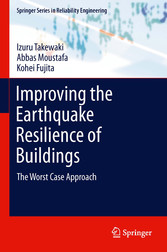Suchen und Finden
Improving the Earthquake Resilience of Buildings - The worst case approach
Engineers are always interested in the worst-case scenario. One of the most important and challenging missions of structural engineers may be to narrow the range of unexpected incidents in building structural design. Redundancy, robustness and resilience play an important role in such circumstances. Improving the Earthquake Resilience of Buildings: The worst case approach discusses the importance of worst-scenario approach for improved earthquake resilience of buildings and nuclear reactor facilities.
Improving the Earthquake Resilience of Buildings: The worst case approach consists of two parts. The first part deals with the characterization and modeling of worst or critical ground motions on inelastic structures and the related worst-case scenario in the structural design of ordinary simple building structures. The second part of the book focuses on investigating the worst-case scenario for passively controlled and base-isolated buildings. This allows for detailed consideration of a range of topics including:
A consideration of damage of building structures in the critical excitation method for improved building-earthquake resilience,
A consideration of uncertainties of structural parameters in structural control and base-isolation for improved building-earthquake resilience, and
New insights in structural design of super high-rise buildings under long-period ground motions.
Improving the Earthquake Resilience of Buildings: The worst case approach is a valuable resource for researchers and engineers interested in learning and applying the worst-case scenario approach in the seismic-resistant design for more resilient structures.
Dr. Izuru Takewaki is a Professor in the Department of Architecture and Architectural Engineering, College of Engineering, Kyoto University, Japan. Dr. Takewaki authored more than 100 international journal papers and authored 4 monographs in English on Structural Optimization, Critical Excitation Methods and Structural Health Monitoring. He serves as an editorial board member in several international journals (e.g. Engineering Structures, Soil Dynamics and Earthquake Engineering, Structural Control and Health Monitoring). He is one of the Editors-in-Chief of Int J of Earthquakes and Structures.
Dr. Abbas Moustafa is an Associate Professor at the Department of Civil Engineering, Minia University, Egypt and the Chairman of the Department of Civil Engineering, High Institute of Engineering, Giza, Egypt. He is also a consultant engineer and head of structural group, Hamza Associates, Giza, Egypt. He has about 30 international journal papers and is the editor of two books on earthquake-resistant structures and geotechnical earthquake engineering. Dr. Moustafa was a JSPS fellow at Kyoto and Nagasaki Universities and was also a research associate at Vanderbilt University.
Dr. Kohei Fujita is a post doctoral fellow in Kyoto University, Japan. Dr. Fujita received a PhD from Kyoto University in 2012. He authored more than 10 international journal papers.
Alle Preise verstehen sich inklusive der gesetzlichen MwSt.







